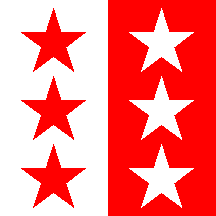
This page is part of © FOTW Flags Of The World website
Valais / Wallis canton (Switzerland)
Last modified: 2006-07-27 by pascal gross
Keywords: valais | wallis | star |
Links: FOTW homepage |
search |
disclaimer and copyright |
write us |
mirrors
![[Flag of Valais/Wallis]](../images/c/ch-vs.gif) by António Martins
by António Martins
See also:
Description of the flag
Per pale argent and gules, thirteen mullets of five: in each field
four in pale and five on the palar line, all countercoloured.
Divided vertically into equal parts white (hoist) and red (fly). In
the white field and four red five-pointed stars arranged vertically.
In the red field are four white five-pointed stars arranged
vertically. A third row of five stars straddles the dividing line,
each star half red and half white opposite to the field colour. The
stars all have one point directed toward the top of the flag. They
are often incorrectly depicted fimbriated in black.
Symbolism of the flag
Red and white are the colours of the Bishop of Sion, the dominant
power in Valais until very recent times. The thirteen stars
represent the thirteen districts (Zehnden) of Valais, a number that
has remained constant since 1815 when Valais joined the Swiss
Confederation.
History of the flag
Valais, straddling the upper Rhone valley, was an important
territory to the ancient Romans due to the mountains passes linking
Italy to transalpine Europe. The monastery of St. Maurice, named for
a Roman Christian officer martyred in Valais, was founded in 390.
Valais was initially hostile to the Swiss Confederation but became
allied with it in 1403 after the Burgundian wars. The earliest known
war flag is the vertically divided red and white banner of the
Bishop of Sion, and has been documented at 1220. Valais consisted
of highly autonomous "Dixains" (Zehnden) owing allegiance to the
Bishop. Their own individual banners predominated until 1613 when
they united into a republic. The red and white flag of the republic
originally had six stars for its constituent Dixains. A seventh was
added in 1628, and in that year France, Savoy and Switzerland all
recognised Valais as a free republic.
In 1798 the French created the Helvetic Republic with Valais as one
of its new cantons. When the Helvetic Republic proved an unworkable
artificial creation, Napoleon mediated the restoration of the Swiss
Confederation in 1803, but kept Valais out of the new polity in order
to guarantee French control of the strategic mountain passes. In
severing Valais from Switzerland, the five Dixains of lower Valais
were joined to it for a total of twelve stars in the flag (six in
each field). In 1810 France annexed Valais outright as the
Department of Simplon.
Since the Act of Mediation of 1803 was a Napoleonic creation, it
collapsed with him, and the Allies restored the pre-revolutionary
Confederation in 1815 with the addition of three new cantons
liberated from France. Valais thus rejoined Switzerland, and in the
process created a thirteenth Dixain (Conthey) out of parts of two
others (Martigny and Sion). The flag was accordingly altered to its
current form with thirteen stars in three rows.
T.F. Mills, 04 November 1997
 by António Martins
by António Martins
From 1498-1628 there were six stars in the arms.
António Martins, 25 October 1998
Flaggen, Knatterfahnen and Livery Colours
|
![[Knatterfahnen]](../images/c/ch-vs_f.gif)
|
![[Knatterfahnen]](../images/c/ch-vs_kf.gif)
|
![[livery colours]](../images/c/ch-vs_ff.gif)
|
by Pascal Gross
Flaggen are vertically hoisted from a crossbar in the manner of gonfanon, in ratio of about 2:9, with a swallowtail that indents about 2 units. The chief, or hoist (square part) usually incorporates the design from the coat of arms - not from the flag. The fly part is always divided lengthwise, usually in a bicolour, triband or tricolour pattern (except Schwyz which is monocolour, and Glarus which has four stripes of unequal width). The colours chosen for the fly end are usually the main colours of the coat of arms, but the choice is not always straight forward.
Knatterfahnen are similar to Flaggen, but hoisted from the long side and have no swallow tail. They normally show the national, cantonal or communal flag in their chiefs.
Željko Heimer, 16 July 2000
 by António Martins
by António Martins

![[Flag of Valais/Wallis]](../images/c/ch-vs.gif) by António Martins
by António Martins
 by António Martins
by António Martins
![[Knatterfahnen]](../images/c/ch-vs_kf.gif)